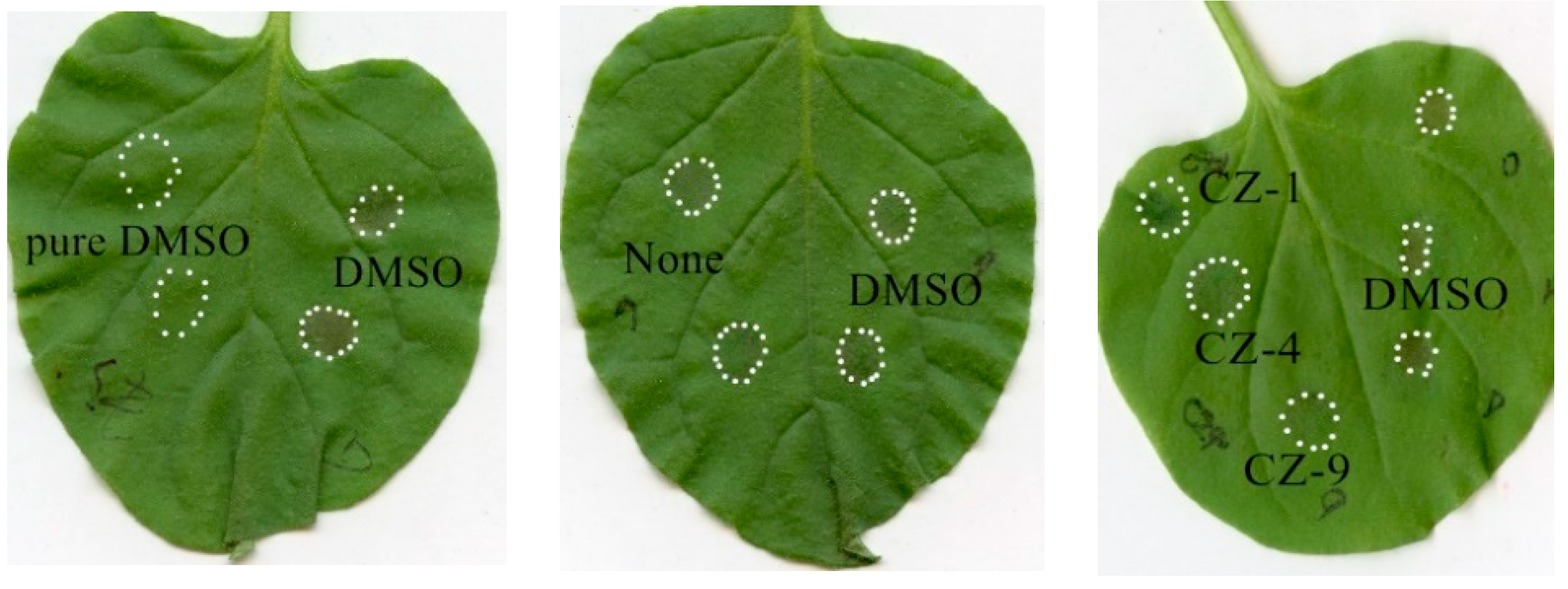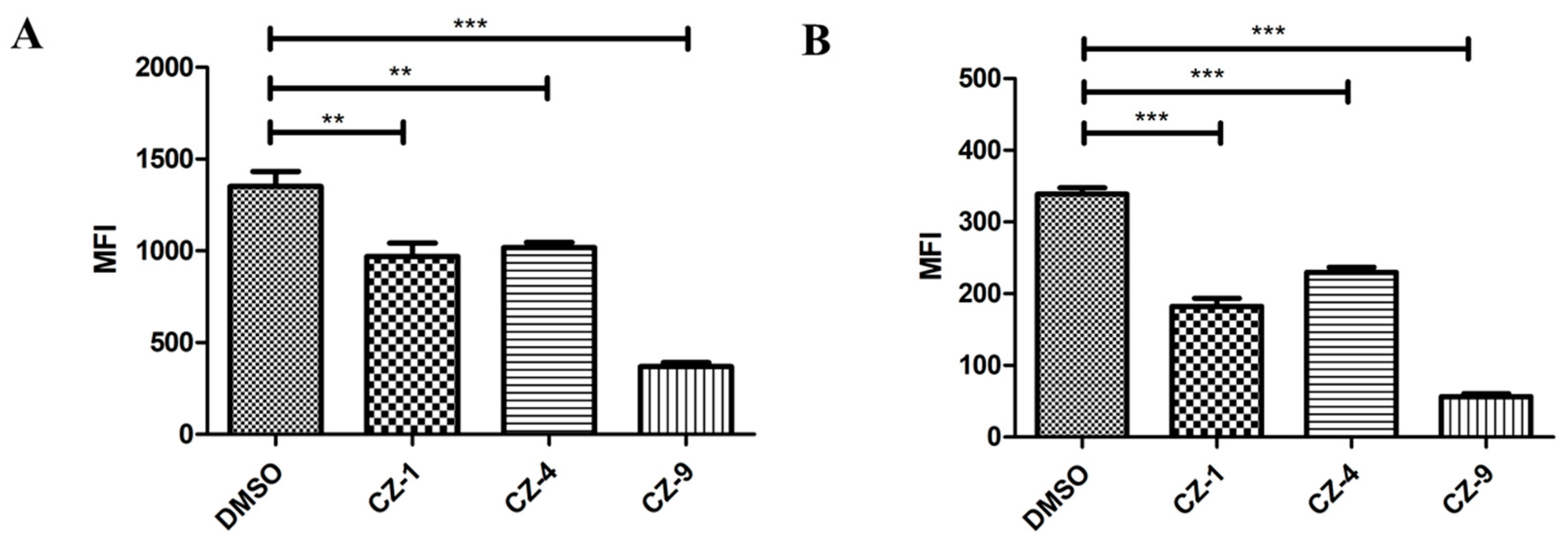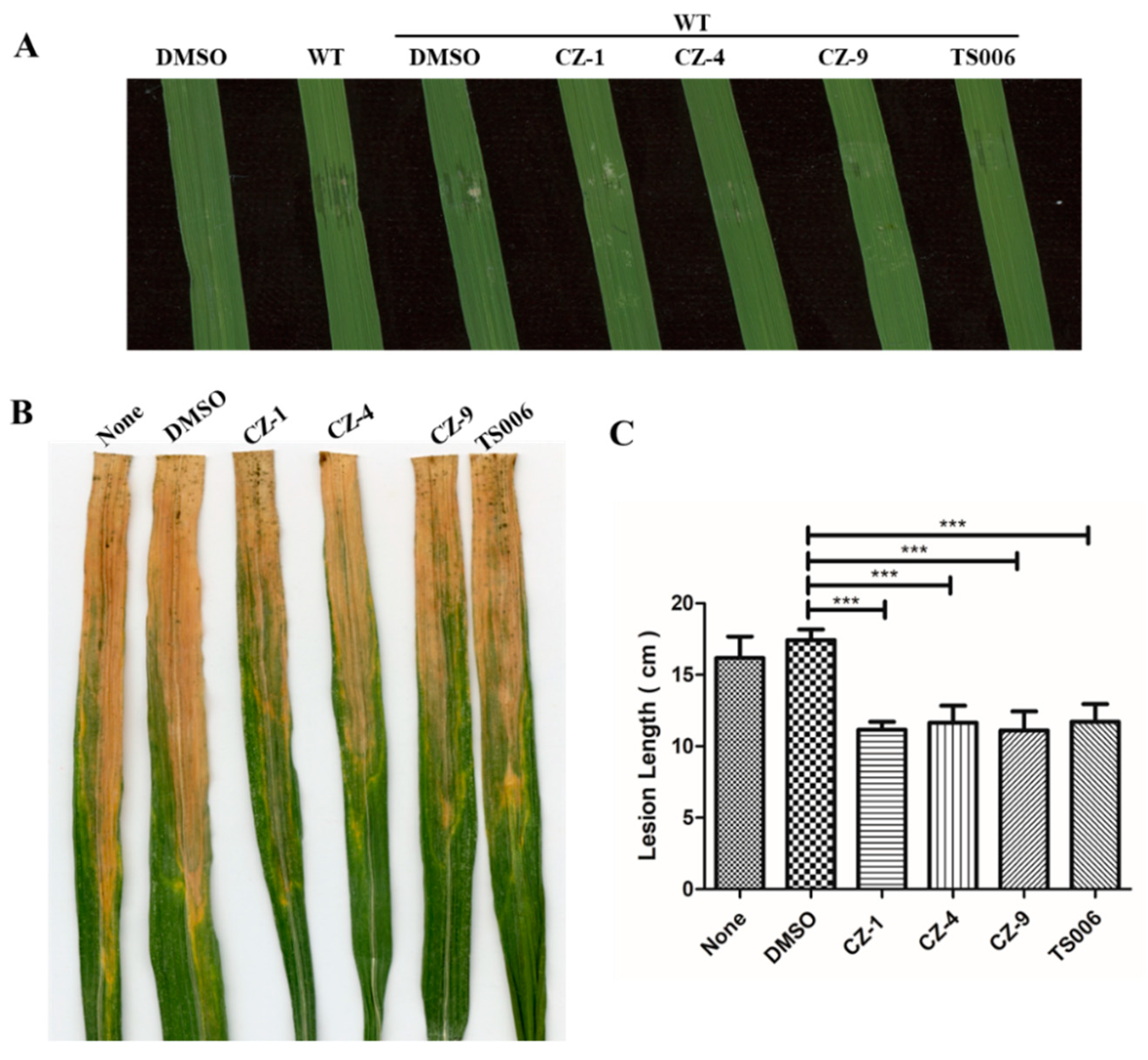Small Molecule Inhibitors Specifically Targeting the Type III Secretion System of Xanthomonas oryzae on Rice
Abstract
:1. Introduction
2. Results and Discussion
2.1. Screening of Inhibitors Which Affect the T3SS of Xoo
2.2. Measurement of Growth Curve
2.3. Three Compounds Suppress the HR Caused by Xoo in Tobacco
2.4. Expression of Representative hrp/hrc Genes is Suppressed by Inhibitors CZ-1, CZ-4 and CZ-9
2.5. The three Inhibitors Affect the Expression of Regulatory Genes hrpG and hrpX
2.6. The promoters of hrcT Respond Differentially to Inhibitors CZ-1, CZ-4 and CZ-9
2.7. CZ-1, CZ-4 and CZ-9 Suppress the Water Soaking and Disease Symptoms of Xoo on Rice
3. Materials and Methods
3.1. Bacterial Strains, Plasmids and Growth Conditions
3.2. Sources of the Screened Compounds
3.3. Flow Cytometry Analysis
3.4. RNA Extraction and qPCR Analysis
3.5. Measurement of the Growth Rate
3.6. HR Assay
3.7. Statistical Analyses
4. Conclusions
Supplementary Materials
Author Contributions
Funding
Acknowledgments
Conflicts of Interest
References
- Rasko, D.A.; Sperandio, V. Anti-virulence strategies to combat bacteria mediated disease. Nat. Rev. Drug Discov. 2010, 9, 117–128. [Google Scholar] [CrossRef] [PubMed]
- Fan, S.S.; Tian, F.; Li, J.Y.; William, H.; Chen, H.M.; Yang, F.H.; Yuan, X.C.; Cui, Z.N.; Yang, C.H.; He, C.Y. Identification of phenolic compounds that suppress the virulence of Xanthomonas oryzae on rice via the type III secretion system. Mol. Plant Pathol. 2017, 18, 555–568. [Google Scholar] [CrossRef] [PubMed]
- Barczak, A.K.; Hung, D.T. Productive steps toward an antimicrobial targeting virulence. Curr. Opin. Microbiol. 2009, 12, 490–496. [Google Scholar] [CrossRef] [PubMed] [Green Version]
- Cornelis, G.R. The type III secretion injectisome. Nat. Rev. 2006, 4, 811–825. [Google Scholar] [CrossRef] [PubMed]
- Büttner, D. Protein export according to schedule: Architecture, assembly, and regulation of type III secretion systems from plant- and animal-pathogenic bacteria. Microbiol. Mol. Biol. Rev. 2012, 76, 262–310. [Google Scholar] [CrossRef] [PubMed]
- Marshall, N.C.; Finlay, B.B. Targeting the type III secretion system to treat bacterial infections. Expert Opin. Ther. Targets. 2014, 18, 137–152. [Google Scholar] [CrossRef] [PubMed]
- Charro, N.; Mota, L.J. Approaches targeting the type III secretion system to treat or prevent bacterial infections. Expert Opin. Drug. Discov. 2015, 10, 373–387. [Google Scholar] [CrossRef] [PubMed]
- Felise, H.B.; Nguyen, H.V.; Pfuetzner, R.A.; Barry, K.C.; Jackson, S.R.; Blanc, M.P.; Bronstein, P.A.; Kline, T.; Miller, S.I. An inhibitor of gramnegative bacterial virulence protein secretion. Cell Host Microbe. 2008, 4, 325–336. [Google Scholar] [CrossRef] [PubMed]
- Wang, D.; Zetterstrom, C.E.; Gabrielsen, M.; Beckham, K.S.H.; Tree, J.J.; Macdonald, S.E.; Byron, O.; Mitchell, T.J.; Herzyk, P.; Mahajan, A. Identification of bacterial target proteins for the salicylidene acylhydrazide class of virulence-blocking compounds. J. Biol. Chem. 2011, 286, 29922–29931. [Google Scholar] [CrossRef] [PubMed]
- Jessen, D.L.; Bradley, D.S.; Nilles, M.L. A type III secretion system inhibitor targets YopD while revealing differential regulation of secretion in calcium blind mutants of Yersinia pestis. Antimicrob. Agents Chemother. 2014, 8, 839–850. [Google Scholar] [CrossRef] [PubMed]
- Yang, F.; Korban, S.S.; Pusey, P.L.; Elofsson, M.; Sundin, G.W.; Zhao, Y. Small-molecule inhibitors suppress the expression of both type III secretion and amylovoran biosynthesis genes in Erwinia amylovora. Mol. Plant Pathol. 2014, 15, 44–57. [Google Scholar] [CrossRef] [PubMed]
- Bowlin, N.O.; Williams, J.D.; Knoten, C.A.; Torhan, M.C.; Tashjian, T.F.; Li, B.; Aiello, D.; Mecsas, J.; Hauser, A.R.; Peet, N.P. Mutations in the Pseudomonas aeruginosa needle protein gene pscF confer resistance to phenoxyacetamide inhibitors of the type III secretion system. Antimicrob. Agents Chemother. 2014, 58, 2211–2220. [Google Scholar] [CrossRef] [PubMed]
- Garrity-Ryan, L.K.; Kim, O.K.; Balada-Llasat, J.M.; Bartlett, V.J.; Verma, A.K.; Fisher, M.L.; Castillo, C.; Songsungthong, W.; Tanaka, S.K.; Levy, S.P. Small molecule inhibitors of LcrF, a Yersinia pseudotuberculosis transcription factor, attenuate virulence and limit infection in a murine pneumonia model. Infect. Immun. 2010, 78, 4683–4690. [Google Scholar] [CrossRef] [PubMed]
- Nino-Liu, D.O.; Ronald, P.C.; Bogdanove, A.J. Xanthomonas oryzae pathovars: Model pathogens of a model crop. Mol. Plant Pathol. 2006, 7, 303–324. [Google Scholar] [CrossRef] [PubMed]
- Sundaram, R.M.; Chatterjee, S.; Oliva, R.; Laha, G.S.; Cruz, C.V.; Leach, J.E. Update on bacterial blight of rice: Fourth international conference on bacterial blight. Rice 2014, 7, 12. [Google Scholar] [CrossRef] [PubMed]
- Zou, L.F.; Wang, X.P.; Xiang, Y.; Zhang, B.; Li, Y.R.; Xiao, Y.L.; Wang, J.S.; Walmsley, A.R.; Chen, G.Y. Elucidation of the hrp clusters of Xanthomonas oryzae pv. oryzicola that control the hypersensitive response in nonhost tobacco and pathogenicity in susceptible host rice. Appl. Environ. Microbiol. 2006, 72, 6212–6224. [Google Scholar] [CrossRef] [PubMed]
- Cho, H.J.; Park, Y.J.; Noh, T.H.; Kim, Y.T.; Kim, J.G.; Song, E.S. Molecular analysis of the hrp gene cluster in Xanthomonas oryzae pathovar oryzae KACC10859. Microb. Pathog. 2008, 44, 473–483. [Google Scholar] [CrossRef] [PubMed]
- Alfano, J.R.; Collmer, A. The type III (Hrp) secretion pathway of plant pathogenic bacteria: Trafficking harpins, Avr proteins, and death. J. Bacteriol. 1997, 179, 5655–5662. [Google Scholar] [CrossRef] [PubMed]
- Salzberg, S.L.; Sommer, D.D.; Schatz, M.C.; Phillippy, A.M.; Rabinowicz, P.D.; Tsuge, S. Genome sequence and rapid evolution of the rice pathogen Xanthomonas oryzae pv. oryzae PXO99A. BMC Genomics 2008, 9, 204. [Google Scholar] [CrossRef]
- White, F.F.; Yang, B. Host and pathogen factors controlling the rice–Xanthomonas oryzae interaction. Plant Physiol. 2009, 150, 1677–1686. [Google Scholar] [CrossRef] [PubMed]
- Tsuge, S.; Furutani, A.; Fukunaka, R.; Oku, T.; Tsuno, K.; Ochiai, H.; Inoueh, Y.; Kakuy, I.; Kubo, A. Expression of Xanthomonas oryzae pv. oryzae hrp genes in XOM2, a novel synthetic medium. J. Gen. Plant Pathol. 2002, 68, 363–371. [Google Scholar] [CrossRef]
- Tang, X.; Xiao, Y.; Zhou, J.M. Regulation of the type III secretion system in phytopathogenic bacteria. Mol. Plant Microbe Interact. 2006, 19, 1159–1166. [Google Scholar] [CrossRef] [PubMed]
- Wengelnik, K.; Bonas, U. HrpXv, an AraC-type regulator, activates expression of five of the six loci in the hrp cluster of Xanthomonas campestris pv. vesicatoria. J. Bacteriol. 1996, 178, 3462–3469. [Google Scholar] [CrossRef] [PubMed]
- Wengelnik, K.; Van den Ackerveken, G.; Bonas, U. HrpG, a key hrp regulatory protein of Xanthomonas campestris pv. vesicatoria is homologous to two-component response regulators. Mol. Plant Microbe Interact. 1996, 9, 704–712. [Google Scholar] [CrossRef] [PubMed]
- Chatterjee, A.; Cui, Y.; Chatterjee, A.K. Regulation of Erwinia carotovora hrpL (Ecc) (sigma-L(Ecc)), which encodes an extracytoplasmic function subfamily of sigma factor required for expression of the HRP regulon. Mol. Plant Microbe Interact. 2002, 15, 971–980. [Google Scholar] [CrossRef] [PubMed]
- Xiao, Y.; Heu, S.; Yi, J.; Lu, Y.; Hutcheson, S.W. Identification of a putative alternate sigma factor and characterization of a multicomponent regulatory cascade controlling the expression of Pseudomonas syringae pv. syringae Pss61 hrp and hrmA genes. J. Bacteriol. 1994, 176, 1025–1036. [Google Scholar] [CrossRef] [PubMed]
- Noel, L.; Thieme, F.; Nennstiel, D.; Bonas, U. cDNA-AFLP analysis unravels a genome-wide hrpG-regulon in the plant pathogen Xanthomonas campestris pv. vesicatoria. Mol. Microbiol. 2001, 41, 1271–1281. [Google Scholar] [CrossRef] [PubMed]
- Furutanin, A.; Tsuge, S.; Oku, T.; Tsuno, K.; Inoue, Y.; Ochiai, H.; Kaku, H.; Kubo, Y. Hpa1 secretion via type III secretion system in Xanthomonas oryzae pv. oryzae. J. Gen. Plant Pathol. 2003, 69, 271–275. [Google Scholar] [CrossRef]
- Wang, X.Y.; Song, C.F.; Miao, W.G.; Ji, Z.L.; Wang, X.; Zhang, Y.; Zhang, J.H.; Hu, J.S.; Wayne Borth, W.; Wang, J.S. Mutations in the N-terminal coding region of the harpin protein Hpa1 from Xanthomonas oryzae cause loss of hypersensitive reaction induction in tobacco. Appl. Microbiol. Biotechnol. 2008, 81, 359–369. [Google Scholar] [CrossRef] [PubMed]
- Li, Y.; Peng, Q.; Selimi, D.; Wang, Q.; Charkowski, A.O.; Chen, X.; Yang, C.H. The plant phenolic compound p-coumaric acid represses gene expression in the Dickeya dadantii type III secretion system. Appl. Environ. Microb. 2009, 75, 1223–1228. [Google Scholar] [CrossRef] [PubMed]
- Yang, S.; Peng, Q.; San Francisco, M.; Wang, Y.; Zeng, Q.; Yang, C.H. Type III secretion system genes of Dickeya dadantii 3937 are induced by plant phenolic acids. PLoS ONE 2008, 3, e2973. [Google Scholar] [CrossRef]
- Yamazaki, A.; Li, J.; Zeng, Q.; Khokhani, D.; Hutchins, W.C.; Yost, A.C.; Biddle, E.; Toone, E.J.; Chen, X.; Yang, C.H. Derivatives of plant phenolic compound affect the type III secretion system of Pseudomonas aeruginosa via a GacS–GacA two-component signal transduction system. Antimicrob. Agents Chemother. 2012, 56, 36–43. [Google Scholar] [CrossRef] [PubMed]
- Khokhani, D.; Zhang, C.; Li, Y.; Wang, Q.; Zeng, Q.; Yamazaki, A.; Hutchins, W.; Zhou, S.S.; Chen, X.; Yang, C.H. Discovery of plant phenolic compounds that act as type III secretion system inhibitors or inducers of the fire blight pathogen, Erwinia amylovora. Appl. Environ. Microb. 2013, 79, 5424–5436. [Google Scholar] [CrossRef] [PubMed]
- Gürlebeck, D.; Thieme, F.; Bonas, U. Type III effector proteins from the plant pathogen Xanthomonas and their role in the interaction with the host plant. J. Plant Physiol. 2006, 163, 233–255. [Google Scholar] [CrossRef] [PubMed]
- Li, Y.R.; Zou, H.S.; Che, Y.Z.; Cui, Y.P.; Guo, W.; Zou, L.F.; Chatterjee, S.; Biddle, E.M.; Yang, C.H.; Chen, G.Y. A novel regulatory role of HrpD6 in regulating hrp-hrc-hpa genes in Xanthomonas oryzae pv. oryzicola. Mol. Plant Microbe Interact. 2011, 24, 1086–1101. [Google Scholar] [CrossRef] [PubMed]
- Andrade, M.O.; Farah, C.S.; Wang, N. The post-transcriptional regulator rsmA/csrA activates T3SS by stabilizing the 5’ UTR of hrpG, the master regulator of hrp/hrc genes, in Xanthomonas. PLoS Pathog. 2014, 10, e1003945. [Google Scholar] [CrossRef] [PubMed]
- Verdier, V.; Triplett, L.R.; Hummel, A.W.; Corral, R.; Cernadas, R.A.; Schmidt, C.L.; Bogdanove, A.J.; Leach, J.E. Transcription activator-like (TAL) effectors targeting OsSWEET genes enhance virulence on diverse rice (Oryza sativa) varieties when expressed individually in a TAL effector-deficient strain of Xanthomonas oryzae. New Phytol. 2012, 196, 1197–1207. [Google Scholar] [CrossRef] [PubMed]
- Livak, K.J.; Schmittgen, T.D. Analysis of relative gene expression data using real-time quantitative PCR and the 2(-Delta Delta C(T)) method. Methods 2001, 25, 402–408. [Google Scholar] [CrossRef] [PubMed]








| Compound | Avg MFI ± SD a | DMSO% b | Inhibition Rate % (100%—DMSO%) |
|---|---|---|---|
| DMSO | 12754.03 ± 534.05 | ||
| CZ-1 | 1754.60 ± 14.71 * | 13.76 | 86.24 |
| CZ-2 | 3781.20 ± 125.84 * | 29.65 | 70.35 |
| CZ-3 | 3951.57 ± 408.15 * | 30.98 | 69.02 |
| CZ-4 | 1849.17 ± 87.95 * | 14.50 | 85.50 |
| CZ-5 | 1049.47 ± 43.36 * | 8.23 | 91.77 |
| CZ-6 | 11181.52 ± 258.22 | 87.67 | 12.33 |
| CZ-7 | 2842.00 ± 100.47 * | 22.28 | 77.72 |
| CZ-8 | 705.25 ± 185.00 * | 5.53 | 94.47 |
| CZ-9 | 726.43 ± 11.25 * | 5.70 | 94.3 |
| DMSO | 17185.37 ± 2439.44 | ||
| FP1 | 3482.30 ± 569.36 * | 20.26 | 79.74 |
| FP2 | 25248.53 ± 2983.44 | 146.92 | −46.92 |
| FP3 | 21246.93 ± 801.74 | 123.63 | −23.63 |
| FP4 | 6747.17 ± 1114.18 * | 39.26 | 60.74 |
| FP5 | 19622.43 ± 676.17 | 114.18 | −14.18 |
| FP6 | 13012.07 ± 606.73 | 75.72 | 24.28 |
| FP7 | 20247.13 ± 5916.35 | 117.82 | −17.82 |
| FP8 | 112.57 ± 2.54 * | 0.66 | 99.34 |
| FP9 | 19572.67 ± 2290.71 | 113.89 | −13.89 |
| FP10 | 17977.20 ± 2973.48 | 104.61 | −4.61 |
| FP11 | 22372.47 ± 1607.45 | 130.18 | −30.18 |
| FP12 | 6355.20 ± 683.35 * | 36.98 | 63.02 |
| FP13 | 6942.47 ± 1340.16 | 40.40 | 59.60 |
| FP15 | 9733.60 ± 1209.31 | 56.64 | 43.36 |
| DMSO | 4378.07 ± 400.82 | ||
| HF1 | 3646.93 ± 961.61 | 83.30 | 16.70 |
| HF6 | 181.63 ± 3.57 * | 4.15 | 95.85 |
| HF8 | 3715.17 ± 347.52 | 84.86 | 15.14 |
| HF11 | 182.40 ± 8.07 * | 4.17 | 95.83 |
| HF12 | 1022.33 ± 148.35 * | 23.35 | 76.65 |
| HF13 | 1466.87 ± 52.55 * | 33.50 | 66.50 |
| HF15 | 190.20 ± 16.62 * | 4.34 | 95.66 |
| HF17 | 161.10 ± 3.43 * | 3.68 | 96.32 |
| HF18 | 1432.37 ± 180.47 * | 32.72 | 67.28 |
| HF19 | 1852.33 ± 278.62 | 42.31 | 57.69 |
| FP31 | 5504.43 ± 625.60 | 125.73 | −25.73 |
| Strains and Plasmids | Relevant Characteristics | Reference or Source |
|---|---|---|
| Strains | ||
| Xanthomonas oryzae pv. oryzae | ||
| PXO99A | Wild-type strain, Philippine race 6, Cpr | Dr. Chenyang He |
| Xanthomonas oryzae pv. oryzicola | ||
| RS105 Wild-type | Chinese race 2 | Dr. Fengquan Liu |
| Plasmids | ||
| pPROBE-AT | Promoter-probe vector, Apr | |
| pPhpa1 pProbe-AT | Derivative with PCR fragment containing hpa1 promoter region, Apr | Dr. Chenyang He |
| pPhrcT pProbe-AT | Derivative with PCR fragment containing hrcT promoter region, Apr | Dr. Chenyang He |
| pPhrpG pProbe-AT | Derivative with PCR fragment containing hrpG promoter region, Apr | Dr. Chenyang He |
| pPhrpX pProbe-AT | Derivative with PCR fragment containing hrpX promoter region, Apr | Dr. Chenyang He |
© 2019 by the authors. Licensee MDPI, Basel, Switzerland. This article is an open access article distributed under the terms and conditions of the Creative Commons Attribution (CC BY) license (http://creativecommons.org/licenses/by/4.0/).
Share and Cite
Tao, H.; Fan, S.-S.; Jiang, S.; Xiang, X.; Yan, X.; Zhang, L.-H.; Cui, Z.-N. Small Molecule Inhibitors Specifically Targeting the Type III Secretion System of Xanthomonas oryzae on Rice. Int. J. Mol. Sci. 2019, 20, 971. https://0-doi-org.brum.beds.ac.uk/10.3390/ijms20040971
Tao H, Fan S-S, Jiang S, Xiang X, Yan X, Zhang L-H, Cui Z-N. Small Molecule Inhibitors Specifically Targeting the Type III Secretion System of Xanthomonas oryzae on Rice. International Journal of Molecular Sciences. 2019; 20(4):971. https://0-doi-org.brum.beds.ac.uk/10.3390/ijms20040971
Chicago/Turabian StyleTao, Hui, Su-Su Fan, Shan Jiang, Xuwen Xiang, Xiaojing Yan, Lian-Hui Zhang, and Zi-Ning Cui. 2019. "Small Molecule Inhibitors Specifically Targeting the Type III Secretion System of Xanthomonas oryzae on Rice" International Journal of Molecular Sciences 20, no. 4: 971. https://0-doi-org.brum.beds.ac.uk/10.3390/ijms20040971




